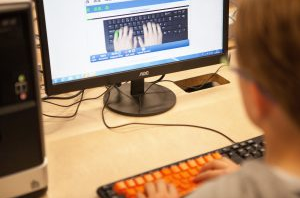April 23, 2020
Why touch typing is beneficial for children with dyspraxia (DCD)?

Why touch typing is beneficial for children with dyspraxia (DCD)?
Dyspraxia (DCD) is a difficulty with thinking out, planning, and carrying out sensory/motor tasks. A recent study of nearly 7,000 seven and eight-year-olds in the UK found that just under two children in every 100 may have dyspraxia. This study used strict criteria for diagnosing the condition, which may explain why other sources suggest that six or eight people in every 100 may have dyspraxia.
Dyspraxia is more common in boys and sometimes runs in families. It may also occur alongside other conditions, such as attention deficit hyperactivity disorder ADHD.
Dyspraxia can make the process of writing laborious and even painful. This is why touch typing (keyboarding) is so frequently recommended for those with dyspraxia. Becoming more familiar with the keyboard or learning to touch type (being able to type with multiple fingers without looking at the keyboard) can be very helpful for children.
Once students are able to touch type successfully with accuracy and speed. This can help students unlock their potential and transfer easily their ideas onto electronic format without the frustration experienced when handwriting. Creativity is unlocked and the student’s self-esteem greatly enhanced.
The keyboard has many important advantages:
- It increases legibility and clarity of presentation
- Increased speed of the input
- Spelling – learning physical letter patterns on the keyboard can be helpful with the spelling of some words
- Reduces the physical pressure and concentration of handwriting- pressing a key can be much easier than manipulating a pen or pencil
- Editing work is easier
- Confidence. The keyboard may allow the child to record work more independently and to produce the required work in the time allowed.
At Searsol, we have worked with children with dyspraxia to teach them how to learn to touch type. Children with dyspraxia need careful guidance and help so they can master the skills of touch typing. Searsol offers touch typing courses in our typing centres



